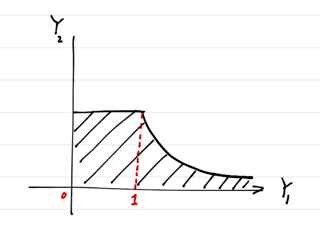Method 1: Let $X_1\sim U(0,1)$ and $X_2\sim U(0,1)$. Since $X_1$ and $X_2$ are independent, $$f_{X_1,X_2}(x_1,x_2)=f_{X_1}(x_1).f_{X_2}(x_2)=1.$$
Define $Y_1=\frac{X_1}{X_2}$ and $Y_2=X_2$. It means that $Y_1=u_1(X_1,X_2)$ and $Y_2=u_2(X_1,X_2)$ where $u_1(x_1,x_2)=\frac{x_1}{x_2}$ and $u_2(x_1,x_2)=x_2$. Now, let's find $X_1,X_2$ in terms of $Y_1,Y_2$. We get:
$$X_1=Y_1Y_2 \mbox{ and } X_2=Y_2.$$
In other words, $X_1=v_1(Y_1,Y_2)$ and $X_2=v_2(Y_2)$ where $v_1(y_1,y_2)=y_1y_2$ and $v_2(y_1,y_2)=y_2$.
Calculate the Jacobian and we have
$$J= \det\left[\begin{matrix}\frac{\partial v_1}{\partial y_1} & \frac{\partial v_1}{\partial y_2} \\ \frac{\partial v_2}{\partial y_1} & \frac{\partial v_2}{\partial y_2} \end{matrix}\right] =\det\left[\begin{matrix}y_2 & y_1 \\ 0 & 1 \end{matrix}\right]=y_2. $$
So we have
$$f_{Y_1,Y_2}(y_1,y_2)=f_{X_1,X_2}(v_1(y_1,y_1),v_2(y_1,y_2))\cdot|J| = y_2.$$
Now, we can calculate the marginal pdf of $Y_1$. Note that the region
$$\{(x_1,x_2)\mid 0<x_1<1,0<x_2<1\}$$
maps to the region
$$\{(y_1,y_2)\mid y_1>0,y_2<\min\{1,1/y_1\}\}.$$

So we have:
$$f_{Y_1}(y_1)=\int f_{Y_1,Y_2}(y_1,y_2)dy_2=\left\{\begin{matrix} \int_{0}^{1}y_2dy_2 & 0<y_1<1\\ \int_{0}^{\frac{1}{y_1}}y_2dy_2 & y_1>1\end{matrix}\right. = \left\{\begin{matrix} \frac{1}{2} & 0<y_1<1 \\ \frac{1}{2y_1^2} & y_1>1.\end{matrix}\right.$$
Method 2: Let $X_1\sim U(0,1)$ and $X_2\sim U(0,1)$. Since $X_1$ and $X_2$ are independent, $$f_{X_1,X_2}(x_1,x_2)=f_{X_1}(x_1)\cdot f_{X_2}(x_2)=1.$$ Let $Z=\frac{X_2}{X_1}$. We have
$$F(z)=P(Z\le z) = P\left(\frac{X_2}{X_1} \le z\right) = P(X_2\le zX_1).$$
Note that if $0<z<1$, then the slope of the line $X_2=zX_1$ is less than 1 and this line is in region 1 (below the line $X_2=X_1$), otherwise it will be in region 2 (above the line $X_2=X_1$) (See the picture).

So we have
$$ F(z)= P(X_2\le zX_1)=\left\{ \begin{matrix} \int_{0}^{1}\int_{0}^{zx_1} 1dx_2dx_1 & 0<z<1 \\ \int_{0}^{1/z}\int_{0}^{zx_1} 1dx_2dx_1+\int_{1/z}^{1}\int_{0}^{1} 1dx_2dx_1 & z>1 \end{matrix}\right.$$
$$ =\left\{ \begin{matrix} \frac{1}{2}z & 0<z<1 \\ 1-\frac{1}{2z} & z>1 \end{matrix}\right.$$
So, the pdf is
$$ f(z)=\left\{ \begin{matrix} \frac{1}{2} & 0<z<1 \\ \frac{1}{2z^2} & z>1 \end{matrix}\right.$$


